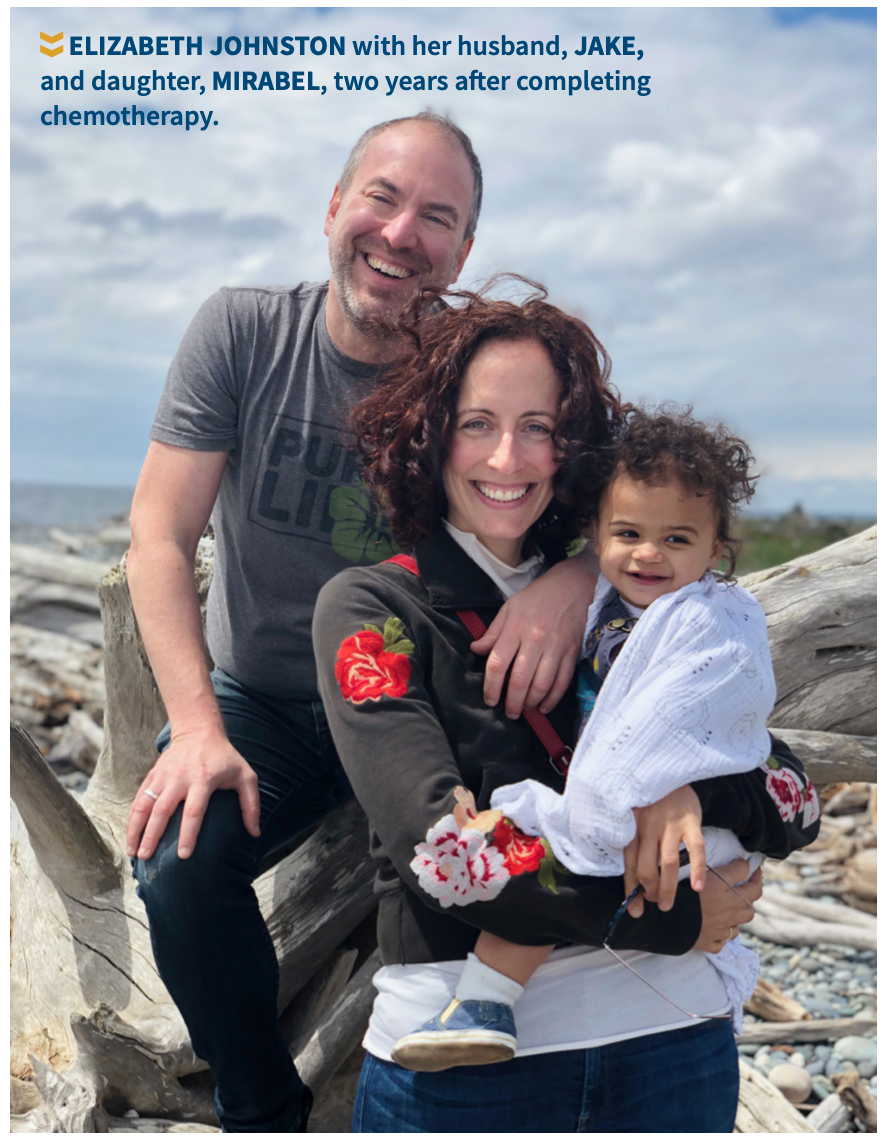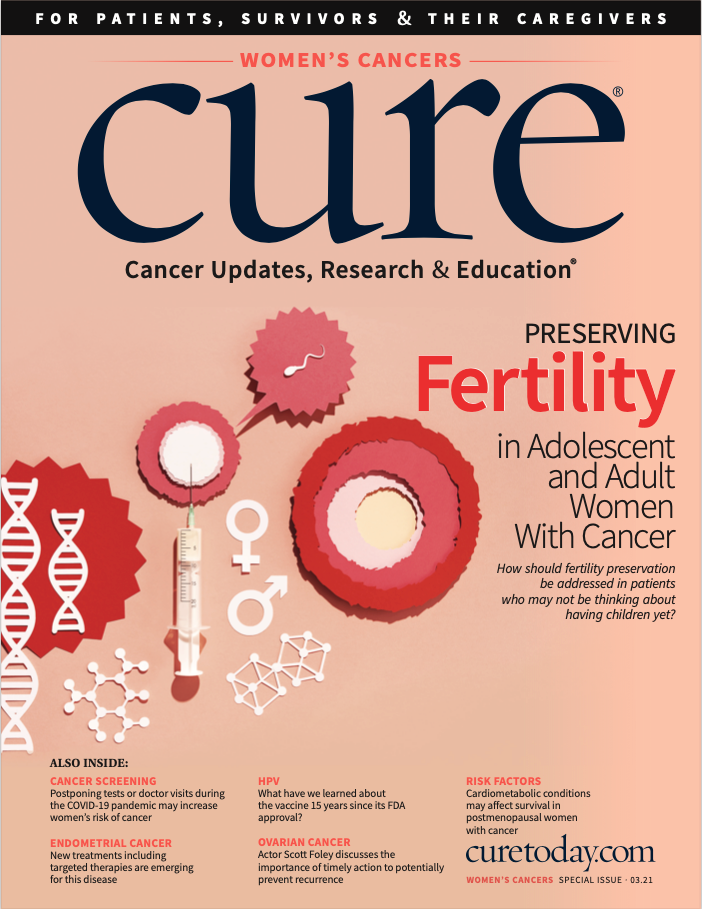Embracing a Different Perspective After Ovarian Cancer
Fertility treatments led to a cancer diagnosis but also opened the door to adoption and a new view on life.
Elizabeth Johnston used to teach reading and writing to students with remedial needs at the City University of New York, but she has stayed home since July 2018, when her daughter was born. Johnston had a tumultuous year starting in February 2017, when she received a diagnosis of ovarian cancer a couple of days before her 39th birthday. She was younger than the average age when ovarian cancer is often diagnosed, which is around 50 or 60.
“In many ways, I was very lucky because I think one of the challenges with ovarian cancer is (that) it’s often caught much later, since there are fewer symptoms; the symptoms that exist tend to be misdiagnosed or just assumed to be something else,” Johnston says.

During fertility treatment, Johnston learned that she had ovarian cysts caused by endometriosis, but her doctor was not concerned. A year and a half later, she underwent an endometrial biopsy before her first embryo transfer to ensure her “chances were as good as possible,” Johnston says, especially as there were not many embryos to transfer. The biopsy results indicated precancer in her uterus. This did concern her doctor, especially because one of her cysts had significantly grown in size.
“It looked a little concerning, (but) the doctors still didn’t think it was likely that I would have had cancer, since I was young,” Johnston says. “I didn’t have any risk factors. There was (no cancer) in my family.”
Her reproductive endocrinologist referred her to a gynecologic oncologist for a biopsy. Johnston received a diagnosis of stage 1 ovarian cancer, although there was a surface metastasis on her colon where it touched her ovary. She says her disease staging was somewhat unclear, as she was told she technically had stage 2 cancer because of the metastasis, but her records indicated stage 1 cancer. Despite the discrepancy, her doctor ensured her there was no difference in treatment from one stage to another based on her presentation.
Her gynecologic oncologist removed the affected ovary and left her uterus and the other ovary, Johnston says. The surface metastasis was treated with six rounds of chemotherapy with CarboTaxol (a combination of paclitaxel and carboplatin), which ended in July 2017.
Johnston chose to remove her other ovary after finishing chemotherapy because she and her husband decided not to have any more egg retrievals performed as part of their fertility treatment.
“I had the opportunity to transfer the embryos that we had, which I also consider myself lucky for because ... a lot of women don’t (have that chance),” Johnston says. “When they face this diagnosis, (women) might get a hysterectomy and have their reproductive choices taken away from them. We, at least, still got to try to implant the few embryos we had, but none of them took.”
Johnston and her gynecologic oncologist discussed starting hormone therapy, including “the side effects that were the hardest, dealing with the menopause symptoms and physical changes that happen,” she explains. Before starting this treatment, her doctor performed another biopsy of Johnston’s uterus, which indicated that the precancer had returned; it was just six months after she had finished chemotherapy. This led to her having a hysterectomy to remove her uterus.
After the hysterectomy, Johnston started taking low-dose estrogen in pill form and as a cream, both of which she says helped to a degree. She still had some side effects, including hot flashes and trouble sleeping, which resulted in a small increase in the dose that helped a lot, she says. Johnston also had issues with intimacy after the procedure, which affected her both physically and psychologically. She saw a therapist to work through the issues, and she also saw a pelvic floor therapist.

“(My husband has) been very understanding about ways (my hysterectomy) has affected intimacy,” Johnston says. “We have very good communication, (but) it hasn’t been easy, and that’s taken a lot of communication and patience.”
Johnston and her husband put all their attention into adoption after her hysterectomy; it was an option they had previously considered.
“Emotionally, adoption was hard, as was IVF, in terms of the process, but at the end, once you have a kid ... I don’t even remember how hard it was,” Johnston says.
Johnston and her husband adopted their daughter at birth in July 2018, a year after she completed treatment, which she credits to helping her feel better. The year following treatment was difficult, even with a strong support system.
“After having finished treatment, everyone’s so excited that you’re done and happy for you,” Johnston says.
“When I was in treatment, I kept waiting to complete that last round so that I would be done with chemotherapy, but then I still felt pretty terrible afterward. ... It took much longer than I expected to (start feeling better). I felt like I was still dealing with this process, and the people around me had moved on, like they no longer thought of me as having cancer.”
Johnston, now 42, recently had her checkups reduced from every three months to every six months thanks to good blood work and scans. Even with these successes, the thought of cancer has not escaped her mind.
“I still think about cancer, but I’m not as anxious as I think I had been in that year after treatment,” Johnston says. “If it were to come back, I know that there are lots of treatments available, and I just have to keep on top of appointments so that if it does come back, we, again, catch it early.”
Johnston advises women, especially those younger than 50, to listen to their body even though ovarian cancer does not have a consistent set of symptoms. She added that some of her symptoms were bloating and abdominal discomfort, which were likely associated with her 9- to 10-centimeter cyst. She also had abdominal pain two to three months before she received a diagnosis of ovarian cancer, which was reminiscent of the pain she would have with her period from endometriosis.
Three and a half years later, the stay-at-home mom is planning a new professional direction and applying for Master of Social Work programs, which she hopes to start part time in the fall when her daughter will be in preschool.
“I feel good. I’m excited about taking a new direction professionally,” Johnston says. “(My) perspective has changed. ... I still want to work hard and care about my work and do something beneficial for society, but I want to have a balance in my life and prioritize that. That hadn’t been something I really put enough emphasis on before. ... There is a way, I guess, where you can think about life before (cancer) and after, and with time and space, I feel optimistic about the future. And my daughter’s pretty awesome, so that’s a great thing to have come out of this.”
For more news on cancer updates, research and education, don’t forget to subscribe to CURE®’s newsletters here.

The Essence of Remarkable Cancer Care
April 29th 2024This year marks the 18th year that CURE and Oncology Nursing News have hosted the Extraordinary Healer Award for Oncology Nursing, which gives people the opportunity to recognize and honor the oncology nurses who have made a significant impact on their life.
Read More